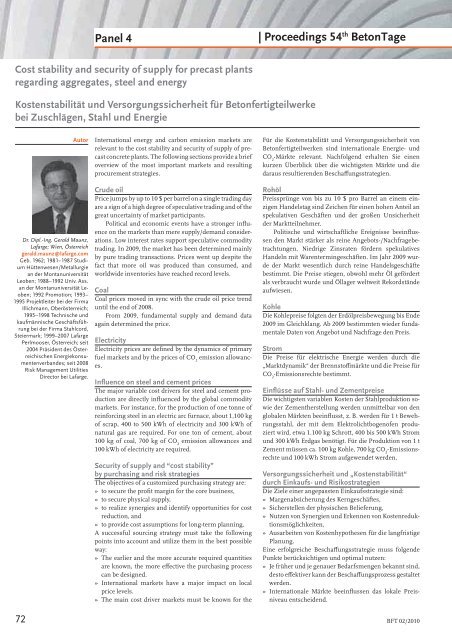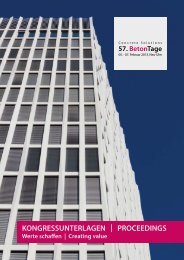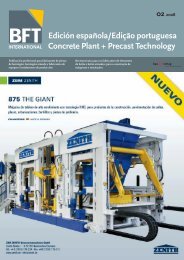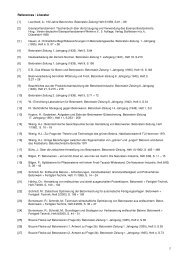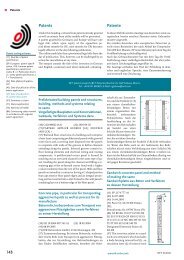Concrete Plant + Precast Technology Betonwerk ... - BFT International
Concrete Plant + Precast Technology Betonwerk ... - BFT International
Concrete Plant + Precast Technology Betonwerk ... - BFT International
Erfolgreiche ePaper selbst erstellen
Machen Sie aus Ihren PDF Publikationen ein blätterbares Flipbook mit unserer einzigartigen Google optimierten e-Paper Software.
72<br />
Panel 4<br />
Cost stability and security of supply for precast plants<br />
regarding aggregates, steel and energy<br />
Kostenstabilität und Versorgungssicherheit für Betonfertigteilwerke<br />
bei Zuschlägen, Stahl und Energie<br />
Autor<br />
Dr. Dipl.-Ing. Gerald Maunz,<br />
Lafarge; Wien, Österreich<br />
gerald.maunz@lafarge.com<br />
Geb. 1962; 1981–1987 Studium<br />
Hüttenwesen/Metallurgie<br />
an der Montanuniversität<br />
Leoben; 1988–1992 Univ. Ass.<br />
an der Montanuniversität Leoben;<br />
1992 Promotion; 1993–<br />
1995 Projektleiter bei der Firma<br />
Illichmann, Oberösterreich;<br />
1995–1998 Technische und<br />
kaufmännische Geschäftsführung<br />
bei der Firma Stahlcord,<br />
Steiermark; 1999–2007 Lafarge<br />
Perlmooser, Österreich; seit<br />
2004 Präsident des ÖsterreichischenEnergiekonsumentenverbandes;<br />
seit 2008<br />
Risk Management Utilities<br />
Director bei Lafarge.<br />
<strong>International</strong> energy and carbon emission markets are<br />
relevant to the cost stability and security of supply of precast<br />
concrete plants. The following sections provide a brief<br />
overview of the most important markets and resulting<br />
procurement strategies.<br />
Crude oil<br />
Price jumps by up to 10 $ per barrel on a single trading day<br />
are a sign of a high degree of speculative trading and of the<br />
great uncertainty of market participants.<br />
Political and economic events have a stronger infl uence<br />
on the markets than mere supply/demand considerations.<br />
Low interest rates support speculative commodity<br />
trading. In 2009, the market has been determined mainly<br />
by pure trading transactions. Prices went up despite the<br />
fact that more oil was produced than consumed, and<br />
worldwide inventories have reached record levels.<br />
Coal<br />
Coal prices moved in sync with the crude oil price trend<br />
until the end of 2008.<br />
From 2009, fundamental supply and demand data<br />
again determined the price.<br />
Electricity<br />
Electricity prices are defi ned by the dynamics of primary<br />
fuel markets and by the prices of CO 2 emission allowances.<br />
Infl uence on steel and cement prices<br />
The major variable cost drivers for steel and cement production<br />
are directly infl uenced by the global commodity<br />
markets. For instance, for the production of one tonne of<br />
reinforcing steel in an electric arc furnace, about 1,100 kg<br />
of scrap, 400 to 500 kWh of electricity and 300 kWh of<br />
natural gas are required. For one ton of cement, about<br />
100 kg of coal, 700 kg of CO 2 emission allowances and<br />
100 kWh of electricity are required.<br />
Security of supply and “cost stability”<br />
by purchasing and risk strategies<br />
The objectives of a customized purchasing strategy are:<br />
» to secure the profi t margin for the core business,<br />
» to secure physical supply,<br />
» to realize synergies and identify opportunities for cost<br />
reduction, and<br />
» to provide cost assumptions for long-term planning.<br />
A successful sourcing strategy must take the following<br />
points into account and utilize them in the best possible<br />
way:<br />
» The earlier and the more accurate required quantities<br />
are known, the more eff ective the purchasing process<br />
can be designed.<br />
» <strong>International</strong> markets have a major impact on local<br />
price levels.<br />
» The main cost driver markets must be known for the<br />
| Proceedings 54 th BetonTage<br />
Für die Kostenstabilität und Versorgungssicherheit von<br />
Betonfertigteilwerken sind internationale Energie- und<br />
CO 2 -Märkte relevant. Nachfolgend erhalten Sie einen<br />
kurzen Überblick über die wichtigsten Märkte und die<br />
daraus resultierenden Beschaff ungsstrategien.<br />
Rohöl<br />
Preissprünge von bis zu 10 $ pro Barrel an einem einzigen<br />
Handelstag sind Zeichen für einen hohen Anteil an<br />
spekulativen Geschäften und der großen Unsicherheit<br />
der Marktteilnehmer.<br />
Politische und wirtschaftliche Ereignisse beeinfl ussen<br />
den Markt stärker als reine Angebots-/Nachfragebetrachtungen.<br />
Niedrige Zinsraten fördern spekulatives<br />
Handeln mit Warentermingeschäften. Im Jahr 2009 wurde<br />
der Markt wesentlich durch reine Handelsgeschäfte<br />
bestimmt. Die Preise stiegen, obwohl mehr Öl gefördert<br />
als verbraucht wurde und Öllager weltweit Rekordstände<br />
aufwiesen.<br />
Kohle<br />
Die Kohlepreise folgten der Erdölpreisbewegung bis Ende<br />
2009 im Gleichklang. Ab 2009 bestimmten wieder fundamentale<br />
Daten von Angebot und Nachfrage den Preis.<br />
Strom<br />
Die Preise für elektrische Energie werden durch die<br />
„Marktdynamik“ der Brennstoff märkte und die Preise für<br />
CO 2 -Emissionsrechte bestimmt.<br />
Einfl üsse auf Stahl- und Zementpreise<br />
Die wichtigsten variablen Kosten der Stahlproduktion sowie<br />
der Zementherstellung werden unmittelbar von den<br />
globalen Märkten beeinfl usst, z. B. werden für 1 t Bewehrungsstahl,<br />
der mit dem Elektrolichtbogenofen produziert<br />
wird, etwa 1.100 kg Schrott, 400 bis 500 kWh Strom<br />
und 300 kWh Erdgas benötigt. Für die Produktion von 1 t<br />
Zement müssen ca. 100 kg Kohle, 700 kg CO 2 -Emissionsrechte<br />
und 100 kWh Strom aufgewendet werden.<br />
Versorgungssicherheit und „Kostenstabilität“<br />
durch Einkaufs- und Risikostrategien<br />
Die Ziele einer angepassten Einkaufsstrategie sind:<br />
» Margenabsicherung des Kerngeschäftes,<br />
» Sicherstellen der physischen Belieferung,<br />
» Nutzen von Synergien und Erkennen von Kostenreduktionsmöglichkeiten,<br />
» Ausarbeiten von Kostenhypothesen für die langfristige<br />
Planung.<br />
Eine erfolgreiche Beschaff ungsstrategie muss folgende<br />
Punkte berücksichtigen und optimal nutzen:<br />
» Je früher und je genauer Bedarfsmengen bekannt sind,<br />
desto eff ektiver kann der Beschaff ungsprozess gestaltet<br />
werden.<br />
» <strong>International</strong>e Märkte beeinfl ussen das lokale Preisniveau<br />
entscheidend.<br />
<strong>BFT</strong> 02/2010


